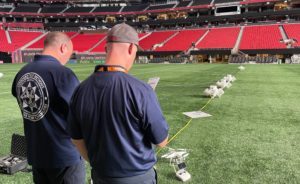 APSA and AIRT Collaborate to Support Public Safety Drone Use of NIST Test Methods for sUAS
APSA and AIRT Collaborate to Support Public Safety Drone Use of NIST Test Methods for sUAS
by DRONELIFE Staff Writer Ian M. Crosby
Non-profit organizations the Airborne Public Safety Association (APSA) and the Airborne International Response Team (AIRT) have entered into an agreement of cooperation in order to support the implementation of the National Institute for Standards and Technology (NIST) Test Methods for Small Unmanned Aircraft Systems (sUAS) to improve upon the safety and proficiency surrounding public safety drone operations.
The agreement will see APSA and AIRT – the official home of the DRONERESPONDERS program – collaborate to promote validation and dissemination of the NIST test methods for sUAS. The two organizations will work together in developing best practices for using the tests to support training with standard measures of remote pilot proficiency for public safety and emergency services organization operating drones for life safety missions.
“The NIST test methods for sUAS have emerged as a proven system for evaluating both remote pilot proficiency and aircraft capabilities,” said APSA Executive Director and CEO Daniel Schwarzbach. “Our partnership with AIRT and the DRONERESPONDERS program will help expand awareness and adoption of the NIST test methods while also ensuring a safer National Airspace System (NAS).”
APSA currently provides basic and advanced-level proctor training courses for public safety agencies looking to adopt the NIST test methods for sUAS, as well as a Basic Proficiency Evaluation for Remote Pilots (BPERP) certification. The DRONERESPONDERS program, with the support of a grant from NIST, will assist in validating and disseminating the test methods while supporting the courses. In addition, the organizations will maintain a record of public safety agencies and personnel who have successfully completed the training.
“We look forward to working alongside APSA to help establish much-needed standardization surrounding public safety and emergency drone operations,” said Chief Charles Werner (ret.), Director of DRONERESPONDERS. “The skill development and objective measures of proficiency provided by the NIST test methods are ideal for law enforcement, fire service, and other public safety agencies who are typically operating small, quad-copter drones.”
The NIST test methods for sUAS offer an adaptable method of training and measuring remote pilot proficiency for both professional and recreational pilots, while also lowering risk to ground personnel and manned aircraft operating in the NAS. NIST test lanes can be constructed easily from supplies typically found at most hardware stores. APSA and AIRT will compile the average scores for remote pilots on various aircraft within the NIST test methods, allowing any organization using similar aircraft to establish their own minimum thresholds of proficiency.
“We are excited to have APSA and DRONERESPONDERS work together to introduce the NIST test methods for sUAS to America’s first responders operating drones,” said Adam Jacoff, a robotics research engineer in NIST’s Intelligent Systems Division. “Their efforts will help make public safety drone operations more effective, and safer, for all stakeholders.”
Read more about AIRT and DRONERESPONDERS:
- AIRT Building Worlds Largest Air Force of Emergency Response Remote Pilots and Drones
- DRONERESPONDERS Florida Public Safety Coordination Group: Working Together to Use Drones Effectively
- AIRT Awarded Federal Grant to Improve Public Safety Drone Operations
- DRONERESPONDERS and NUAIR Partner to Help New York Public Safety Agencies Implement Drone Tech
- Public Safety Drone Programs: Key Questions, Key Answers from AIRT Public Safety UAS Survey
 Ian attended Dominican University of California, where he received a BA in English in 2019. With a lifelong passion for writing and storytelling and a keen interest in technology, he is now contributing to DroneLife as a staff writer.
Ian attended Dominican University of California, where he received a BA in English in 2019. With a lifelong passion for writing and storytelling and a keen interest in technology, he is now contributing to DroneLife as a staff writer.

Miriam McNabb is the Editor-in-Chief of DRONELIFE and CEO of JobForDrones, a professional drone services marketplace, and a fascinated observer of the emerging drone industry and the regulatory environment for drones. Miriam has penned over 3,000 articles focused on the commercial drone space and is an international speaker and recognized figure in the industry. Miriam has a degree from the University of Chicago and over 20 years of experience in high tech sales and marketing for new technologies.
For drone industry consulting or writing, Email Miriam.
TWITTER:@spaldingbarker
Subscribe to DroneLife here.







[…] Source link […]